经济学原理 曼昆第七版第四讲讲义:Supply and Demand
中文曼昆宏观经济学第七版讲义

MACROECONOMICS
N. Gregory Mankiw
PowerPoint® Slides by Ron Cronovich
5 C H A P T E R
The Open Economy
© 2011 Worth Publishers, all rights reserved
(exercise)
CHAPTER 5 The Open Economy
18
1. Fiscal policy at home
r
An increase in G
or decrease in T
reduces saving.
r 1*
Results:
I 0
N X S0
S2 S1 NX2
NX1nt, and the trade balance
(percent of GDP) 1960-2019
investment
saving
trade balance (right scale)
U.S.: “The world’s largest debtor nation”
implies
NX = (Y – C – G ) – I
=
S –I
trade balance = net capital outflow
Thus,
a country with a trade deficit (NX < 0) is a net borrower (S < I ).
CHAPTER 5 The Open Economy
c. economy is small: cannot affect the world interest rate, denoted r*
中文曼昆宏观经济学第七版讲义
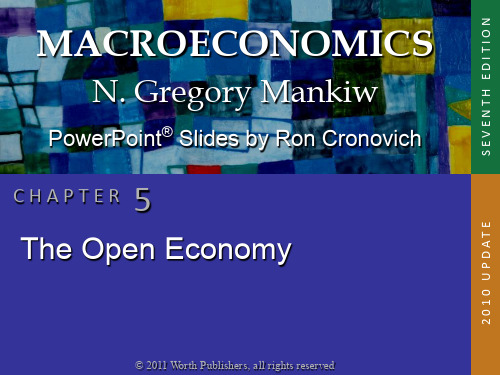
13
Assumptions about capital flows
a. domestic & foreign bonds are perfect substitutes (same risk, maturity, etc.)
b. perfect capital mobility: no restrictions on international trade in assets
I (r* )
S, I
CHAPTER 5 The Open Economy
15
If the economy were closed…
r
…the interest rate would adjust to equate investment
and saving: rc
S
I (r )
CHAPTER 5 The Open Economy
I (rc ) S
S, I
16
But in a small open economy…
r
the exogenous
world interest
rate determines
investment…
r*
…and the
difference
rc
between saving
and investment
determines net
5
The national income identity in an open economy
Y = C + I + G + NX
or, NX = Y – (C + I + G )
net exports
经济学原理曼昆第04章
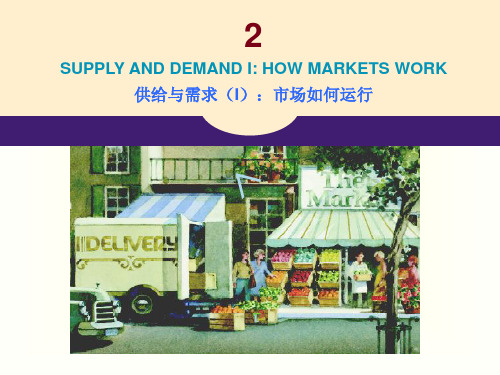
Harcourt, Inc. items and derived items copyright © 2001 by Harcourt, Inc.
竞争: 完全及其它
完全竞争
Harcourt, Inc. items and derived items copyright © 2001 by Harcourt, Inc.
Demand Schedule 需求表
The demand schedule is a table that shows the relationship between the price of the good and the quantity demanded. 需求表 —— 表示一种物品的价格 与需求量之间关系的表格。
Harcourt, Inc. items and derived items copyright © 2001 by Harcourt, Inc.
Catherine’s Demand Schedule
凯瑟琳的需求表
P ric e
价格
$ 0 .0 0 0 .5 0 1 .0 0 1 .5 0 2 .0 0 2 .5 0 3 .0 0
Harcourt, Inc. items and derived items copyright © 2001 by Harcourt, Inc.
Markets
u A market is a group of buyers and sellers of a particular good or service.
Price of Ice-Cream Cone
第七版微观经济学第4章供给与需求的市场力量ppt课件
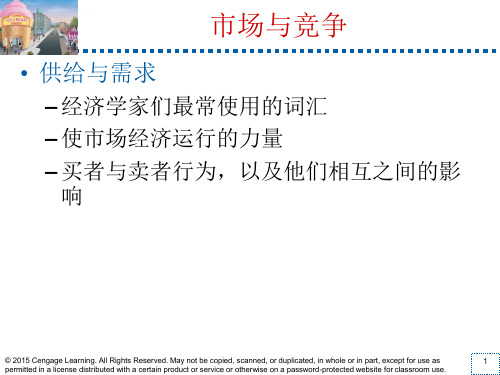
市场与竞争
• 垄断
– 市场上唯一的卖方 – 价格的决定
• 其他的市场
– 在完全竞争与垄断之间
© 2015 Cengage Learning. All Rights Reserved. May not be copied, scanned, or duplicated, in whole or in part, except for use as
9
permitted in a license distributed with a certain product or service or otherwise on a password-protected website for classroom use.
•“雪亮工程"是以区(县)、乡(镇) 、村( 社区) 三级综 治中心 为指挥 平台、 以综治 信息化 为支撑 、以网 格化管 理为基 础、以 公共安 全视频 监控联 网应用 为重点 的“群 众性治 安防控 工程” 。
图1
Catherine需求曲线和需求曲线
冰淇淋的价格
冰淇淋的价 冰淇淋的数
格
量
$0.00 0.50 1.00 1.50 2.00 2.50 3.00
12 cones 10 8 6 4 2 0
$3.00 2.50 2.00 1.50 1.00 0.50
1.价格下降. . . 2. . . . 需求量上升
• 它们在市场上相互作用
© 2015 Cengage Learning. All Rights Reserved. May not be copied, scanned, or duplicated, in whole or in part, except for use as
微观经济学原理第七版曼昆名词解释带英文

微观经济学原理曼昆名词解释1.需求价格弹性price elasticity of demand:2.蛛网模型:对于生产周期较长的商品供给的时滞性,需求的不是动态模型分类,画图3.边际效用递减diminishing marginal utility——基数效用论不违反边际效用递减规律;因为边际效用是指物品的消费量每增加或减少一个单位所增加或减少的总效用的量;这里的“单位”是指一完整的商品单位,这种完整的商品单位,是边际效用递减规律有效性的前提;比如,这个定律适用于一双的鞋子,但不适用于单只的鞋子;对于四轮车而言,必须是有四个轮子的车才成为一单位;三个轮子不能构成一辆四轮车,因而每个轮子都不是一个有效用的物品,增加一个轮子,才能使车子有用;因此,不能说第四个轮子的边际效用超过第三个轮子4.无差异曲线indifference curve:一条表示给消费者相同满足程度的消费组合的曲线;2特征:凸向原点越远越大不相交5.边际替代率marginal rate of :——序数效用论6.预算线Budget line/ budget constraint7.吉芬物品Giffen good:价格上升引起需求量增加的物品;8.柯布道格拉斯生产函数稀缺性scarcity:社会资源的有限性;经济学economics:研究社会如何管理自己的稀缺资源;效率efficiency:社会能从其稀缺资源中得到最多东西的特性;平等equality:经济成果在社会成员中公平分配的特性;机会成本opportunity cost:为了得到某种东西所必须放弃的东西;理性人rational people:系统而有目的地尽最大努力实现起目标的人; 边际变动marginal change:对行动计划微小的增量调整;激励incentive:引起一个人做出某种行为的某种东西;市场经济market economy:当许多企业和家庭在物品与劳务市场上相互交易时,通过他们的分散决策配置资源的经济;产权property rights:个人拥有并控制稀缺资源的能力;市场失灵market failure:市场本身不能有效配置资源的情况;外部性externality:市场势力market power:一个经济活动者或经济活动者的一个小集团对市场价格有显着影响的能力;生产率productivity:一个工人一小时所生产的物品与劳务量;通货膨胀inflation:经济中物价总水平的上升;经济周期business cycle:就业和生产等经济活动的波动就是生产这类经济活动的波动;循环流向图circular-flow diagram:一个说明货币如何通过市场在家庭与企业之间流动的直观经济模型;生产可能性边界production possibilities frontier:表示一个经济在可得到的生产要素与生产技术既定时所能生产的产量的各种组合的图形;微观经济学microeconomics:研究家庭和企业如何做出决策,以及它们在市场上的相互交易;宏观经济学macroeconomics:研究整体经济现象,包括通货膨胀、失业和经济增长; 实证表述positive statements:企图描述世界是什么的观点;规范描述normative statements:企图描述世界应该如何运行的观点;绝对优势absolute advantage:根据生产率比较一种物品的生产者;比较优势comparative advantage :根据机会成本比较一种物品的生产者;进口品imports:国外生产而在国内销售的物品;出口品exports:国内生产而在国外销售的物品;市场market:由某种物品或劳务的买者与卖者组成的一个群体;竞争市场competitive market :有许多买者与卖者,以致于每个人对市场价格的影响都微乎其微的市场;需求量quantity demanded:买者愿意而且能够购买的一种物品量;需求定理law of demand:认为在其他条件相同时,一种物品价格上升,该物品需求量减少的观点;需求表demand schedule:表示一种物品价格与需求量之间关系的表格;需求曲线demand curve:一种物品价格与需求量之间关系的图形;正常物品normal good:在其他条件相同时,收入增加引起需求量增加的物品; 低档物品inferior good:在其他条件相同时,收入增加引起需求量减少的物品; 替代品substitutes:一种物品价格上升引起另一种物品需求增加的两种物品; 互补品complements:一种物品价格上升引起另一种物品需求减少的两种物品; 供给量quantity supplied:卖者愿意而且能够出售的一种物品量;供给定理law of supply:认为在其他条件相同时,一种物品价格上升,该物品供给量增加的观点;供给表supply schedule:表示一种物品价格与供给量之间关系的表格;供给曲线supply curve:一种物品价格与供给量之间关系的图形;均衡equilibrium:供给与需求达到了平衡的状态;均衡价格equilibrium price:使供给与需求平衡的价格;均衡数量equilibrium quantity:当价格调整到使供给与需求平衡时的供给量与需求量;过剩surplus:供给量大于需求量时的状态;短缺shortage:需求量大于供给量时的状态;供求定理law of supply and demand:认为任何一种物品的调整都会使该物品供求平衡的观点;弹性elasticity:需求量或供给量对其决定因素中某一种的反应程度的衡量; 总收益total revenue:一种物品买者支付的量和卖者得到的量,用该物品的价格乘以销售量来计算;需求收入弹性income Elasticity of demand:一种物品需求量对消费者收入变动反应程度的衡量,用需求量变动百分比除以收入变动百分比来计算;需求的交叉价格弹性cross-price elasticity of demand:衡量一种物品需求量对另一种物品价格变动的反应程度,用第一种物品需求量变动百分比除以第二种物品价格变动百分比来计算;供给价格弹性price elasticity of supply:一种物品供给量对其价格变动反应程度的衡量,用供给量变动百分比除以价格变动百分比来计算;价格上限price ceiling:可以出售一种物品的法定最高价格;价格下限price floor:可以出售一种物品的法定最低价格;税收归宿tax incidence:关于由谁来承担税收负担的研究;福利经济学welfare economists:研究资源配置如何影响经济福利;支付意愿willingness to pay:买者愿意为某种物品支付的最高量;消费者剩余consumer surplus:买者的支付意愿减买者的实际支付量;成本cost:卖者为了生产一种物品必须放弃的每种东西的价值;生产者剩余producer Surplus:卖者出售一种物品得到的量减卖者的成本;效率efficiency:资源配置使社会所有成员得到的总剩余最大化的性质;平等equality:福利在社会成员中分配的公平性;无谓损失deadweight loss:税收引起的总剩余减少;世界价格world price:一种物品在世界市场上所流行的价格;关税tariff:对在国外生产而在国内销售的物品征收的税;外部性externality:一个人的行为对旁观者福利的影响;外部性的内在化internalizing the externality :改变激励,以使人们考虑到自己行为的外部效应;科斯定理coase theorem:一种观点,认为如果私人各方可以无成本地就资源配置进行协商,那么,他们就可以解决外部性问题;交易成本transaction cost:各方在协议与遵守协议过程中所发生的成本;庇古税pigovian taxes:用于纠正负外部性影响的税收;排他性excludability:可以阻止一个人使用一种物品时该物品的特性;竞争性rivalry:一个人使用一种物品减少其他人使用时该物品的特性;私人物品private goods:既有排他性又有竞争性的物品;公共物品public goods:既无排他性又无竞争性的物品;公有资源common resources:有竞争性但无排他性的物品;搭便车者free rider:得到一种物品的利益但避开为此支付的人;成本—收益分析coast-benefits analysis:比较提供一种公共物品的社会成本与利益的研究;公地悲剧tragedy of the commons:一个寓言,说明从整个社会的角度看为什么公有资源的使用大于合意的水平;预算盈余budget surplus:政府收入大于政府支出;预算赤字budget deficit:政府支出大于政府收入;平均税率average tax rate:总收入除以支付的总税收;边际税率marginal tax rate:增加1美元收入支出的额外税收;定额税lump-sum tax:每个人等量的税收;受益原则benefits principle:认为应该根据人们从政府服务中得到的利益来纳税的思想;支付能力原则原则ability-to-pay principle:认为应该根据一个人可以承受的负担来对这个人征税的思想;纵向平等vertical equity:主张支付能力高的纳税人应该交纳更多税的思想; 横向平等horizontal equality:主张有相似支付能力的纳税人应该交纳等量税收的思想;比例税proportional tax:高收入纳税人和低收入纳税人交纳收入中相同比例的税收;累退税regressive tax:高收入纳税人交纳的税收在收入中的比例低于低收入纳税人的税收;累进税progressive tax:高收入纳税人交纳的税收在收入中的比例高于低收入纳税人的税收;总收益total revenue:企业出售其产量所得到的量;总成本total cost:企业购买生产投入所支付的量;利润profit:总收益减总成本;显性成本explicit costs:要求企业支出货币的投入成本;隐性成本implicit costs:不要求企业支出货币的投入成本;经济利润economic profit:总收益减总成本,包括与隐性成本;会计利润accounting profit:总收入减显性成本;生产函数production function:用于生产一种物品的投入量与该物品产量之间的关系;边际产量marginal product:增加的一单位投入所引起的产量增加;边际产量递减diminishing marginal product:固定成本fixed costs:不随着产量变动而变动的成本;可变成本variable costs:随着产量变动而变动的成本;平均总成本average total cost:总成本除以产量;平均固定成本average fixed costs:固定成本除以产量;平均可变成本average variable costs:可变成本除以产量;边际成本efficient scale:额外一单位产量所引起的总成本的增加;有效规模efficient scale:使平均总成本最小的产量;规模经济economics of scale:长期平均总成本随产量增加而减少的特性;规模不经济diseconomies of scale:长期平均总成本随产量增加而增加的特性; 规模收益不变constant returns to Scale:长期平均总成本随产量增加而保持不变的特性;竞争市场competitive market:有许多交易相同产品的买者与卖者,以至于每一个买者和卖者都是价格接受者的市场;平均收益average revenue:总收益除以销售量;边际收益marginal revenue:增加一单位销售量引起的总收益变动;沉没成本sunk cost:已经发生而且无法收回的成本;垄断企业monopoly:一种没有相近替代品的产品的惟一卖者的企业;自然垄断natural monopoly:由于一个企业能以低于两个或更多企业的成本向整个市场供给一种物品或劳务而产生的垄断;价格歧视price discrimination:以不同价格向不同顾客出售同一种物品的经营做法;寡头oligopoly:只有少数几个卖者提供相似或相同产品的的市场结构;垄断竞争monopolistic competition:许多出售相似而不相同的产品的企业的市场结构;勾结collusion:一个市场上的企业之间就生产的产量或收取的价格达成的协议; 卡特尔Cartel:一致行动的企业集团;纳什均衡Nash equilibrium:相互作用的经济主体在假定所有其他主体所选战略为既定的情况下选择自己最优战略的状态;博弈论game theory:研究人们在各种策略情况下如何行事;囚徒困境prisoners' dilemma:两个被捕获的囚徒之间的一种特殊“博弈”,说明为什么甚至在合作对双方有利时,保持合作也是困难的;占优优势策略dominant strategy:无论其他参与者选择什么策略,对一个参与者都为最优的策略; 125生产要素:用于生产物品和劳务的投入;生产函数production function:用于生产一种物品的投入量与该物品产量之间的关系;劳动的边际产量marginal product of labor:增加的一单位劳动所引起的产量增加量;边际产量递减diminishing marginal product:一单位投入的边际产量随着投入量增加而减少的性质;边际产量值value of the marginal product:一种投入的边际产量乘以该产品的价格;资本capital:用于生产物品与劳务的设备和建筑物;补偿性工资差别compensating differential:为抵消不同工作的非货币特性而产生的工资差别;人力资本human capital:对人的投资的积累,如教育和在职培训;工会union:与雇主谈判工资和工作条件的工人协会;罢工strike:工会有组织地从企业撤出劳动;效率工资efficiency wages:企业为了提高工人的生产率而支付的高于均衡工资的工资;歧视discrimination:对仅仅由于种族、宗教、性别、年龄或其他个人特征不同的相似个人提供不同的机会;贫困率poverty rate:家庭收入低于一个称为贫困线的绝对水平的人口百分比; 贫困线poverty line:由联邦政府根据每个家庭规模确定的一种收入绝对水平,低于这一水平的家庭被认为处于贫困状态;实物转移支付in-kind transfers:以物品和劳务而不是以现金形式给予穷人的转移支付;生命周期life cycle:在人的一生中有规律的收入变动形式;持久收入permanent income:一个人的正常收入;功利主义utilitarianism:一种政治哲学,根据这种政治哲学,政府应该选择使社会上所有人总效用最大化的政策;效用utility:衡量幸福或满足程度的指标;自由主义liberalism:一种政治哲学,根据这种政治哲学,政府应该选择必要的公正的政策;这种公正要由yield在“无知面纱”的背后的无偏见观察者来评价;最大最小准则maximin criterion:一种主张,认为政府的目标应该是使社会上状况最差的人的福利最大化;社会保险social insurance:旨在保护人们规避负面事件风险的政府政策;自由至上主义libertarianism:一种政治哲学,根据这种政治哲学,政府应该惩罚犯罪并进行自愿的协议,但不应该进行收入再分配;福利welfare:补贴需要者收入的政府计划;负所得税negative income tax:向高收入家庭征税并给低收入家庭补贴的税制; 预算约束线budget constraint:对消费者可以支付得起的消费组合的限制;完全替代品perfect substitutes:无差异曲线为直线的两种物品;完全互补品perfect complements:无差异曲线为直角形的两种物品;收入效应income Effect:当一种价格变动使消费者移动到更高或更低无差异曲线时所引起的消费变动 ;替代效应substitution effect:当一种价格变动使消费者沿着一条既定的无差异曲线变动到有新边际替代率的一点时所引起的消费变动;寻租理论Rent-seeking theory:。
微观经济学原理(第七版)-曼昆-名词解释(带英文)

微观经济学原理曼昆名词解释1.需求价格弹性(price elasticity of demand):2.蛛网模型():对于生产周期较长的商品供给的时滞性,需求的不是动态模型分类,画图3.边际效用递减(diminishing marginal utility)——基数效用论不违反边际效用递减规律。
因为边际效用是指物品的消费量每增加(或减少)一个单位所增加(或减少)的总效用的量。
这里的“单位”是指一完整的商品单位,这种完整的商品单位,是边际效用递减规律有效性的前提。
比如,这个定律适用于一双的鞋子,但不适用于单只的鞋子。
对于四轮车而言,必须是有四个轮子的车才成为一单位。
三个轮子不能构成一辆四轮车,因而每个轮子都不是一个有效用的物品,增加一个轮子,才能使车子有用。
因此,不能说第四个轮子的边际效用超过第三个轮子4.无差异曲线(indifference curve):一条表示给消费者相同满足程度的消费组合的曲线。
(2)特征:凸向原点越远越大不相交5.边际替代率(marginal rate of substitution.MRS):——序数效用论6.预算线(Budget line/ budget constraint)7.吉芬物品(Giffen good):价格上升引起需求量增加的物品。
8.柯布道格拉斯生产函数稀缺性(scarcity):社会资源的有限性。
经济学(economics):研究社会如何管理自己的稀缺资源。
效率(efficiency):社会能从其稀缺资源中得到最多东西的特性。
平等(equality):经济成果在社会成员中公平分配的特性。
机会成本(opportunity cost):为了得到某种东西所必须放弃的东西。
边际变动(marginal change):对行动计划微小的增量调整。
激励(incentive):引起一个人做出某种行为的某种东西。
市场经济(market economy):当许多企业和家庭在物品与劳务市场上相互交易时,通过他们的分散决策配置资源的经济。
经济学原理 曼昆第七版第四讲讲义:Supply and Demand

– Amount of a good that buyers are willing and able to purchase
• Law of demand
– Other things equal – When the price of a good rises, the
Demand curve, D2
Quantity of Ice-Cream Cones
Any change that raises the quantity that buyers wish to purchase at any given price shifts the demand curve to the right. Any change that lowers the quantity that buyers wish to purchase at any given price shifts the demand curve to the left.
• As the price of the good varies • Other things constant
A
13
Figure 2
Market Demand as the Sum of Individual Demands
The quantity demanded in a market is the sum of the quantities demanded by all the buyers at each price. Thus, the market demand curve is found by adding horizontally the individual demand curves. At a price of $2.00, Catherine demands 4 ice-cream cones, and Nicholas demands 3 ice-cream cones. The quantity demanded in the market at this price is 7 cones.
2023-曼昆《经济学原理》英文版完整讲义丛elasticity
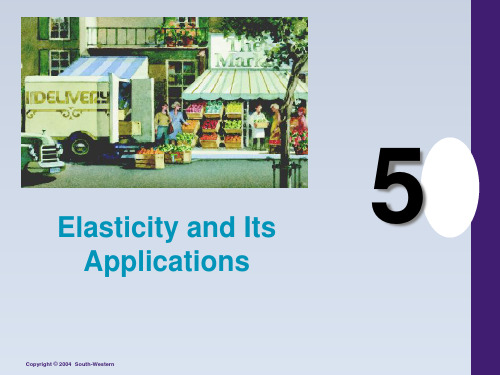
(a) Perfectly Inelastic Demand: Elasticity Equals 0
Quantity
0
Price
Figure 1 The Price Elasticity of Demand
(b) Inelastic Demand: Elasticity Is Less Than 1
TR = P x Q
Figure 2 Total Revenue
Quantity
0
Price
Elasticity and Total Revenue along a Linear Demand Curve
With an inelastic demand curve, an increase in price leads to a decrease in quantity that is proportionately smaller. Thus, total revenue increases.
Figure 3 How Total Revenue Changes When Price Changes: Inelastic Demand
Quantity
0
Price
Quantity
0
Price
An Increase in price from $1 to $3 …
… leads to an Increase in total revenue from $100 to $240
Example: If the price of an ice cream cone increases from $2.00 to $2.20 and the amount you buy falls from 10 to 8 cones, then your elasticity of demand would be calculated as:
微观经济学原理(第七版)曼昆名词解释(带英文)

微观经济学原理曼昆名词解释稀缺性(scarcity):社会资源的有限性。
经济学(economics):研究社会如何管理自己的稀缺资源。
效率(efficiency):社会能从其稀缺资源中得到最多东西的特性。
平等(equality):经济成果在社会成员中公平分配的特性。
机会成本(opportunitycost):为了得到某种东西所必须放弃的东西。
理性人(rationalpeople):系统而有目的地尽最大努力实现起目标的人。
边际变动(marginalchange):对行动计划微小的增量调整。
激励(incentive):引起一个人做出某种行为的某种东西。
市场经济(marketeconomy):当许多企业和家庭在物品与劳务市场上相互交易时,通过他们的分散决策配置资源的经济。
产权(propertyrights):个人拥有并控制稀缺资源的能力。
市场失灵(marketfailure):市场本身不能有效配置资源的情况。
外部性(externality):一个人的行为对旁观者福利的影响。
市场势力(marketpower):一个经济活动者(或经济活动者的一个小集团)对市场价格有显著影响的能力。
生产率(productivity):一个工人一小时所生产的物品与劳务量。
通货膨胀(inflation):经济中物价总水平的上升。
经济周期(businesscycle):就业和生产等经济活动的波动(就是生产这类经济活动的波动。
)循环流向图(circular-flowdiagram):一个说明货币如何通过市场在家庭与企业之间流动的直观经济模型。
生产可能性边界(productionpossibilitiesfrontier):表示一个经济在可得到的生产要素与生产技术既定时所能生产的产量的各种组合的图形。
微观经济学(microeconomics):研究家庭和企业如何做出决策,以及它们在市场上的相互交易。
宏观经济学(macroeconomics):研究整体经济现象,包括通货膨胀、失业和经济增长。
曼昆经济学原理英文版文案加习题答案5章ELASTICITY AND ITS APPLICATION
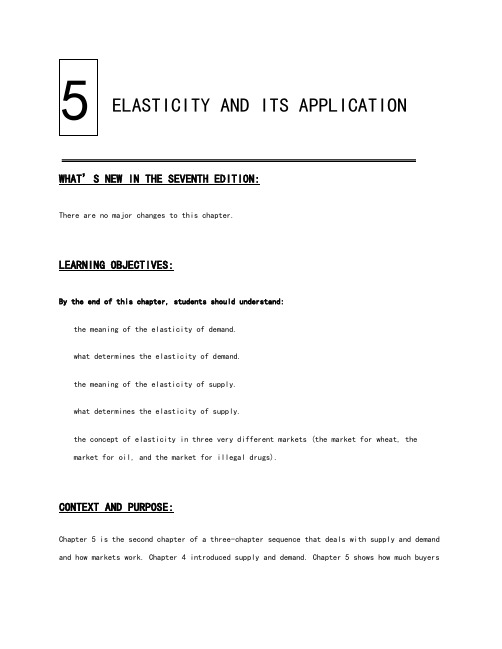
5ELASTICITY AND ITS APPLICATION WHAT’S NEW IN THE S EVENTH EDITION:There are no major changes to this chapter.LEARNING OBJECTIVES:By the end of this chapter, students should understand:the meaning of the elasticity of demand.what determines the elasticity of demand.the meaning of the elasticity of supply.what determines the elasticity of supply.the concept of elasticity in three very different markets (the market for wheat, the market for oil, and the market for illegal drugs).CONTEXT AND PURPOSE:Chapter 5 is the second chapter of a three-chapter sequence that deals with supply and demand and how markets work. Chapter 4 introduced supply and demand. Chapter 5 shows how much buyersand sellers respond to changes in market conditions. Chapter 6 will address the impact of government polices on competitive markets.The purpose of Chapter 5 is to add precision to the supply-and-demand model. We introduce the concept of elasticity, which measures the responsiveness of buyers and sellers to changes in economic variables such as prices and income. The concept of elasticity allows us to make quantitative observations about the impact of changes in supply and demand on equilibrium prices and quantities.KEY POINTS:The price elasticity of demand measures how much the quantity demanded responds to changes in the price. Demand tends to be more elastic if close substitutes are available, if the good is a luxury rather than a necessity, if the market is narrowly defined, or if buyers have substantial time to react to a price change.The price elasticity of demand is calculated as the percentage change in quantity demanded divided by the percentage change in price. If quantity demanded moves proportionately less than the price, then the elasticity is less than one, and demand is said to be inelastic.If quantity demanded moves proportionately more than the price, then the elasticity is greater than one, and demand is said to be elastic.Total revenue, the total amount paid for a good, equals the price of the good times the quantity sold. For inelastic demand curves, total revenue moves in the same direction as the price. For elastic demand curves, total revenue moves in the opposite direction as the price.The income elasticity of demand measures how much the quantity demanded responds tochanges in consumers’ income. The cross-price elasticity of demand measures how much the quantity demanded of one good responds to the price of another good.The price elasticity of supply measures how much the quantity supplied responds to changes in the price. This elasticity often depends on the time horizon under consideration. In most markets, supply is more elastic in the long run than in the short run.The price elasticity of supply is calculated as the percentage change in quantity supplied divided by the percentage change in price. If quantity supplied moves proportionately less than the price, then the elasticity is less than one, and supply is said to be inelastic.If quantity supplied moves proportionately more than the price, then the elasticity is greater than one, and supply is said to be elastic.The tools of supply and demand can be applied in many different kinds of markets. This chapter uses them to analyze the market for wheat, the market for oil, and the market for illegal drugs.CHAPTER OUTLINE:I. The Elasticity of DemandA. Definition of elasticity: a measure of the responsiveness of quantity demanded orquantity supplied to one of its determinants.B. The Price Elasticity of Demand and Its Determinants1. Definition of price elasticity of demand: a measure of how much the quantitydemanded of a good responds to a change in the price of that good, computed as thepercentage change in quantity demanded divided by the percentage change in price.2. Determinants of the Price Elasticity of Demanda. Availability of Close Substitutes: the more substitutes a good has, the moreelastic its demand.b. Necessities versus Luxuries: necessities are more price inelastic.c. Definition of the market: narrowly defined markets (ice cream) have moreelastic demand than broadly defined markets (food).d. Time Horizon: goods tend to have more elastic demand over longer time horizons.C. Computing the Price Elasticity of Demand1. Formula2. Example: the price of ice cream rises by 10% and quantity demanded falls by 20%.Price elasticity of demand = (20%)/(10%) = 23. Because there is an inverse relationship between price and quantity demanded (theprice of ice cream rose by 10% and the quantity demanded fell by 20%), the price elasticity of demand is sometimes reported as a negative number. We will ignorethe minus sign and concentrate on the absolute value of the elasticity.D. The Midpoint Method: A Better Way to Calculate Percentage Changes and Elasticities1. Because we use percentage changes in calculating the price elasticity of demand,the elasticity calculated by going from one point to another on a demand curvewill be different from an elasticity calculated by going from the second point tothe first. This difference arises because the percentage changes are calculatedusing a different base.a. A way around this problem is to use the midpoint method.b. Using the midpoint method involves calculating the percentage change in eitherprice or quantity demanded by dividing the change in the variable by themidpoint between the initial and final levels rather than by the initial levelitself.c. Example: the price rises from $4 to $6 and quantity demanded falls from 120 to80.% change in price = (6 −4)/5 × 100 = 40%% change in quantity demanded = (120 − 80)/100 x 100 = 40%price elasticity of demand = 40/40 = 1E. The Variety of Demand Curves1. Classification of Elasticitya. When the price elasticity of demand is greater than one, demand is defined tobe elastic.b. When the price elasticity of demand is less than one, the demand is defined tobe inelastic.c. When the price elasticity of demand is equal to one, the demand is said to haveunit elasticity.2. In general, the flatter the demand curve that passes through a given point, themore elastic the demand.3. Extreme Casesa. When the price elasticity of demand is equal to zero, the demand is perfectlyinelastic and is a vertical line.b. When the price elasticity of demand is infinite, the demand is perfectlyelastic and is a horizontal line.4. FYI: A Few Elasticities from the Real WorldF. Total Revenue and the Price Elasticity of Demand1. Definition of total revenue: the amount paid by buyers and received by sellers ofa good, computed as the price of the good times the quantity sold.2. If demand is inelastic, the percentage change in price will be greater than thepercentage change in quantity demanded.a. If price rises, quantity demanded falls, and total revenue will rise (becausethe increase in price will be larger than the decrease in quantity demanded).b. If price falls, quantity demanded rises, and total revenue will fall (becausethe fall in price will be larger than the increase in quantity demanded).3. If demand is elastic, the percentage change in quantity demanded will be greaterthan the percentage change in price.a. If price rises, quantity demanded falls, and total revenue will fall (becausethe increase in price will be smaller than the decrease in quantity demanded).b. If price falls, quantity demanded rises, and total revenue will rise (becausethe fall in price will be smaller than the increase in quantity demanded).4. If demand is unit elastic, the percentage change in price will be equal to thepercentage change in quantity demanded.a. If price rises, quantity demanded falls, and total revenue will remain the same(because the increase in price will be equal to the decrease in quantitydemanded).b. If price falls, quantity demanded rises, and total revenue will remain the same(because the fall in price will be equal to the increase in quantity demanded).G. Elasticity and Total Revenue along a Linear Demand Curve1. The slope of a linear demand curve is constant, but the elasticity is not.a. At points with a low price and a high quantity demanded, demand is inelastic.b. At points with a high price and a low quantity demanded, demand is elastic.2. Total revenue also varies at each point along the demand curve.H. Other Demand Elasticities1. Definition of income elasticity of demand: a measure of how much the quantitydemanded of a good responds to a change in consumers’ income, computed as the percentage change in quantity demanded divided by the percentage change in income.a. FormulaFigure 4Note that when demand is elastic and price falls, total revenue rises. Also point out that once demand is inelastic, any further decrease in price% change in quantity demandedIncome elasticity of demand =% change in incomeb. Normal goods have positive income elasticities, while inferior goods havenegative income elasticities.ALTERNATIVE CLASSROOM EXAMPLE:John’s income rises from $20,000 to $22,000 and the quantity of hamburger he buyseach week falls from 2 pounds to 1 pound.% change in quantity demanded = (1−2)/ x 100 = %% change in income = (22,000 −20,000)/21,000 x 100 = %c. Necessities tend to have small income elasticities, while luxuries tend to havelarge income elasticities.2. Definition of cross-price elasticity of demand: a measure of how much the quantitydemanded of one good responds to a change in the price of another good, computedas the percentage change in the quantity demanded of the first good divided by the percentage change in the price of the second good.a. Formulab. Substitutes have positive cross-price elasticities, while complements havenegative cross-price elasticities.ALTERNATIVE CLASSROOM EXAMPLE:The price of apples rises from $ per pound to $ per pound. As a result, thequantity of oranges demanded rises from 8,000 per week to 9,500.% change in quantity of oranges demanded = (9,500 − 8,000)/8,750 x 100 = %% change in price of apples = − / x 100 = 40%II. The Elasticity of SupplyA. The Price Elasticity of Supply and Its Determinants1. Definition of price elasticity of supply: a measure of how much the quantitysupplied of a good responds to a change in the price of that good, computed as thepercentage change in quantity supplied divided by the percentage change in price.2. Determinants of the Price Elasticity of Supplya. Flexibility of sellers: goods that are somewhat fixed in supply (beachfrontproperty) have inelastic supplies.b. Time horizon: supply is usually more inelastic in the short run than in thelong run.B. Computing the Price Elasticity of Supply1. Formula2. Example: the price of milk increases from $ per gallon to $ per gallon and thequantity supplied rises from 9,000 to 11,000 gallons per month.% change in price = –/ × 100 = 10%% change in quantity supplied = (11,000 –9,000)/10,000 × 100 = 20%Price elasticity of supply = (20%)/(10%) = 2C. The Variety of Supply Curves1. In general, the flatter the supply curve that passes through a given point, themore elastic the supply.2. Extreme Casesa. When the elasticity is equal to zero, the supply is said to be perfectlyinelastic and is a vertical line.b. When the elasticity is infinite, the supply is said to be perfectly elastic andis a horizontal line.3. Because firms often have a maximum capacity for production, the elasticity ofsupply may be very high at low levels of quantity supplied and very low at highlevels of quantity supplied.III. Three Applications of Supply, Demand, and ElasticityA. Can Good News for Farming Be Bad News for Farmers1. A new hybrid of wheat is developed that is more productive than those used in thepast. What happens2. Supply increases, price falls, and quantity demanded rises.3. If demand is inelastic, the fall in price is greater than the increase in quantitydemanded and total revenue falls.4. If demand is elastic, the fall in price is smaller than the rise in quantitydemanded and total revenue rises.5. In practice, the demand for basic foodstuffs (like wheat) is usually inelastic.a. This means less revenue for farmers.b. Because farmers are price takers, they still have the incentive to adopt thenew hybrid so that they can produce and sell more wheat.c. This may help explain why the number of farms has declined so dramatically overthe past two centuries.d. This may also explain why some government policies encourage farmers todecrease the amount of crops planted.B. Why Did OPEC Fail to Keep the Price of Oil HighFigure 8Short Run Long Run1. In the 1970s and 1980s, OPEC reduced the amount of oil it was willing to supply toworld markets. The decrease in supply led to an increase in the price of oil and a decrease in quantity demanded. The increase in price was much larger in the short run than the long run. Why2. The demand and supply of oil are much more inelastic in the short run than thelong run. The demand is more elastic in the long run because consumers can adjust to the higher price of oil by carpooling or buying a vehicle that gets bettermileage. The supply is more elastic in the long run because non-OPEC producerswill respond to the higher price of oil by producing more.C. Does Drug Interdiction Increase or Decrease Drug-Related Crime1. The federal government increases the number of federal agents devoted to the waron drugs. What happensa. The supply of drugs decreases, which raises the price and leads to a reductionin quantity demanded. If demand is inelastic, total expenditure on drugs (equalto total revenue) will increase. If demand is elastic, total expenditure willfall.b. Thus, because the demand for drugs is likely to be inelastic, drug-relatedcrime may rise.2. What happens if the government instead pursued a policy of drug educationa. The demand for drugs decreases, which lowers price and quantity supplied. Totalexpenditure must fall (because both price and quantity fall).b. Thus, drug education should not increase drug-related crime.SOLUTIONS TO TEXT PROBLEMS:Quick Quizzes1. The price elasticity of demand is a measure of how much the quantity demanded of agood responds to a change in the price of that good, computed as the percentage change in quantity demanded divided by the percentage change in price.When demand is inelastic (a price elasticity less than 1), a price increase raisestotal revenue, and a price decrease reduces total revenue. When demand is elastic (a price elasticity greater than 1), a price increase reduces total revenue, and a price decrease increases total revenue. When demand is unit elastic (a price elasticity equal to 1), a change in price does not affect total revenue.2. The price elasticity of supply is a measure of how much the quantity supplied of agood responds to a change in the price of that good, computed as the percentage change in quantity supplied divided by the percentage change in price.The price elasticity of supply might be different in the long run than in theshort run because over short periods of time, firms cannot easily change the sizes Figure 9(a) Drug Interdiction (b) Drug Educationof their factories to make more or less of a good. Thus, in the short run, thequantity supplied is not very responsive to the price. However, over longerperiods, firms can build new factories, expand existing factories, close oldfactories, or they can enter or exit a market. So, in the long run, the quantitysupplied can respond substantially to a change in price.3. A drought that destroys half of all farm crops could be good for farmers (at leastthose unaffected by the drought) if the demand for the crops is inelastic. Theshift to the left of the supply curve leads to a price increase that will raisetotal revenue if the price elasticity of demand is less than 1.No one farmer would have an incentive to destroy her crops in the absence of adrought because she takes the market price as given. Only if all farmersdestroyed a portion of their crops together, for example through a governmentprogram, would this plan work to make farmers better off.Questions for Review1. The price elasticity of demand measures how much quantity demanded responds to achange in price. The income elasticity of demand measures how much quantitydemanded responds to changes in consumers' income.2. The determinants of the price elasticity of demand include the availability ofclose substitutes, whether the good is a necessity or a luxury, the breadth of thedefinition of the market, and the time horizon. Goods with close substitutes havegreater elasticities, luxury goods have greater price elasticities thannecessities, goods in more narrowly defined markets have greater elasticities, andthe elasticity of demand is greater the longer the time horizon.3. An elasticity greater than one means that demand is elastic. When the elasticityis greater than one, the percentage change in quantity demanded exceeds thepercentage change in price. When the elasticity equals zero, demand is perfectly inelastic. There is no change in quantity demanded when there is a change in price.4. Figure 1 presents a supply-and-demand diagram, showing the equilibrium price, P,the equilibrium quantity, Q, and the total revenue received by producers. Total revenue equals the equilibrium price times the equilibrium quantity, which is the area of the rectangle shown in the figure.Figure 15. If demand is elastic, an increase in price reduces total revenue. With elasticdemand, the quantity demanded falls by a greater percentage than the price rises.As a result, total revenue moves in the opposite direction as the price. Thus, if price rises, total revenue falls.6. A good with income elasticity less than zero is called an inferior good because asincome rises, the quantity demanded declines.7. The price elasticity of supply is calculated as the percentage change in quantitysupplied divided by the percentage change in price. It measures how much quantity supplied responds to changes in price.8. If a fixed quantity of a good is available and no more can be made, the priceelasticity of supply is zero. Regardless of the percentage change in price, therewill be no change in the quantity supplied.9. Destruction of half of the fava bean crop is more likely to hurt fava bean farmersif the demand for fava beans is very elastic. Destruction of half of the cropcauses the supply curve to shift to the left resulting in a higher price of favabeans. When demand is very elastic, an increase in price leads to a decrease intotal revenue because the decrease in quantity demanded outweighs the increase inprice.Quick Check Multiple Choice1. a2. b3. d4. c5. a6. cProblems and Applications1. a. Mystery novels have more elastic demand than required textbooks because mysterynovels have close substitutes and are a luxury good, while required textbooksare a necessity with no close substitutes. If the price of mystery novels wereto rise, readers could substitute other types of novels, or buy fewer novelsaltogether. But if the price of required textbooks were to rise, students wouldhave little choice but to pay the higher price. Thus, the quantity demanded ofrequired textbooks is less responsive to price than the quantity demanded ofmystery novels.b. Beethoven recordings have more elastic demand than classical music recordingsin general. Beethoven recordings are a narrower market than classical musicrecordings, so it is easier to find close substitutes for them. If the price of Beethoven recordings were to rise, people could substitute other classicalrecordings, like Mozart. But if the price of all classical recordings were torise, substitution would be more difficult. (A transition from classical musicto rap is unlikely!) Thus, the quantity demanded of classical recordings isless responsive to price than the quantity demanded of Beethoven recordings.c. Subway rides during the next five years have more elastic demand than subwayrides during the next six months. Goods have a more elastic demand over longertime horizons. If the fare for a subway ride was to rise temporarily, consumers could not switch to other forms of transportation without great expense orgreat inconvenience. But if the fare for a subway ride was to remain high for a long time, people would gradually switch to alternative forms of transportation.As a result, the quantity demanded of subway rides during the next six monthswill be less responsive to changes in the price than the quantity demanded ofsubway rides during the next five years.d. Root beer has more elastic demand than water. Root beer is a luxury with closesubstitutes, while water is a necessity with no close substitutes. If the price of water were to rise, consumers have little choice but to pay the higher price.But if the price of root beer were to rise, consumers could easily switch toother sodas or beverages. So the quantity demanded of root beer is moreresponsive to changes in price than the quantity demanded of water.2. a. For business travelers, the price elasticity of demand when the price oftickets rises from $200 to $250 is [(2,000 – 1,900)/1,950]/[(250 – 200)/225]= = . For vacationers, the price elasticity of demand when the price oftickets rises from $200 to $250 is [(800 – 600)/700] / [(250 – 200)/225] == .b. The price elasticity of demand for vacationers is higher than the elasticityfor business travelers because vacationers can choose a substitute more easilythan business travelers. For example, vacationers can choose a different mode of transportation (like driving or taking the train), a different destination, a different departure date, and a different return date. They may also choose to not travel at all. Business travelers are less likely to do so because their schedules are less adaptable.3. a. The percentage change in price is equal to – / x 100 = 20%. If the priceelasticity of demand is , quantity demanded will fall by 4% in the short run [ ]. If the price elasticity of demand is , quantity demanded will fall by 14% in the long run [].b. Over time, consumers can make adjustments to their homes by purchasingalternative heat sources such as natural gas or electric furnaces. Thus, they can respond more easily to the change in the price of heating oil in the long run than in the short run.4. If quantity demanded fell, price must have increased according to the law ofdemand. For a price increase to increase total revenue, the percentage increase in the price must be greater than the percentage decline in quantity demanded. Therefore, demand is inelastic.5. , a. The effect on the market for coffee beans is shown in Figure 2. When ahurricane destroys half of the crop, the supply of coffee beans decreases, the price of coffee beans increases, and the quantity decreases.QuantityPrice Figure 2Demand S 1 S 2b. The effect on the market for cups of coffee is shown in Figure 2. When theprice of coffee beans, an important input into the production of a cup ofcoffee, increases, the supply of cups of coffee decreases, the price of a cup of coffee increases, and the quantity decreases.Because cups of coffee have an inelastic demand, when the price of a cup ofcoffee increases, the total expenditure on coffee increases.c. The effect on the market for donuts is shown in Figure 3. When the price ofcoffee increases and the quantity demanded of coffee decreases, consumersdemand fewer donuts because coffee and donuts are complements. When demanddecreases, the price of donuts decreases.Because donuts have an inelastic demand, when the price of donuts decreases,the total expenditure on donuts decreases.6. a. If your income is $10,000, your price elasticity of demand as the price of DVDsrises from $8 to $10 is [(40 – 32)/36]/[(10 – 8)/9] = = 1. If your income is $12,000, the elasticity is [(50 – 45)/]/[(10 – 8)/9] = = .b. If the price is $12, your income elasticity of demand as your income increasesfrom $10,000 to $12,000 is [(30 – 24)/27]/[(12,000 – 10,000)/11,000] = = . Price Figure 3If the price is $16, your income elasticity of demand as your income increases from $10,000 to $12,000 is [(12 – 8)/10]/[(12,000 – 10,000)/11,000] = = .7. a. If Maria always spends one-third of her income on clothing, then her incomeelasticity of clothing demand is one, because maintaining her clothingexpenditures as a constant fraction of her income means the percentage changein her quantity of clothing must equal her percentage change in income.b. Maria's price elasticity of clothing demand is also one, because everypercentage point increase in the price of clothing would lead her to reduce her quantity purchased by the same percentage.c. Because Maria spends a smaller proportion of her income on clothing, then forany given price, her quantity demanded will be lower. Thus, her demand curvehas shifted to the left. Because she will again spend a constant fraction ofher income on clothing, her income and price elasticities of demand remain one.8. a. The percentage change in price (using the midpoint formula) is – / × 100%= %. Therefore, the price elasticity of demand is = , which is very elastic.b. Because the demand is inelastic, the Transit Authority's revenue rises when thefare rises.c. The elasticity estimate might be unreliable because it is only the first monthafter the fare increase. As time goes by, people may switch to other means oftransportation in response to the price increase. So the elasticity may belarger in the long run than it is in the short run.9. Walt's price elasticity of demand is zero, because he wants the same quantityregardless of the price. Jessie's price elasticity of demand is one, because he spends the same amount on gas, no matter what the price, which means hispercentage change in quantity is equal to the percentage change in price.10. a. With a price elasticity of demand of , reducing the quantity demanded ofcigarettes by 20% requires a 50% increase in price, because 20/50 = . With the price of cigarettes currently $2, this would require an increase in the priceto $ a pack using the midpoint method (note that ($ – $2)/$ = .50).b. The policy will have a larger effect five years from now than it does one yearfrom now. The elasticity is larger in the long run, because it may take sometime for people to reduce their cigarette usage. The habit of smoking is hardto break in the short run.c. Because teenagers do not have as much income as adults, they are likely to havea higher price elasticity of demand. Also, adults are more likely to beaddicted to cigarettes, making it more difficult to reduce their quantitydemanded in response to a higher price.11. To determine whether you should increase or decrease the price of admissions, youneed to know if the demand is elastic or inelastic. If demand is elastic, adecline in the price of admissions will increase total revenue. If demand isinelastic, an increase in the price of admissions will cause total revenue to rise.12. A worldwide drought could increase the total revenue of farmers if the priceelasticity of demand for grain is inelastic. The drought reduces the supply of grain, but if demand is inelastic, the reduction of supply causes a large increase in price. Total farm revenue would rise as a result. If there is only a drought in Kansas, Kansas’ production is not a large enough proportion of the total farm product to have much impact on the price. As a result, price does not change (or changes by only a slight amount), while the output by Kansas farmers declines, thus reducing their income.。
2023-曼昆《经济学原理》6供给与需求政府管制

(a) A Price Floor That Is Not Binding
Quantity of
Ice-Cream
Cones
0
Price of
Ice-Cream
Cone
Figure 4 A Market with a Price Floor
0
Rental
Price of
Apartment
Quantity of
Apartments
长期内,供给和需求都富有弹性
较大短缺
How Price Floors Affect Market Outcomes
价格下限如何影响市场结果
When the government imposes a price floor, two outcomes are possible.The price floor is not binding if set below the equilibrium price.The price floor is binding if set above the equilibrium price, leading to a surplus. 有两种可能的结果:如果价格下限低于均衡价格,价格下限没有限制性;如果价格下限高于均衡价格,价格下限有限制性,会产生盈余。
CASE STUDY: Lines at the Gas Pump
Economists blame government regulations that limited the price oil companies could charge for gasoline.
经典案例:加油站前排长队
曼昆 经济学原理06-供给、需求和政府政策-PPT文档资料
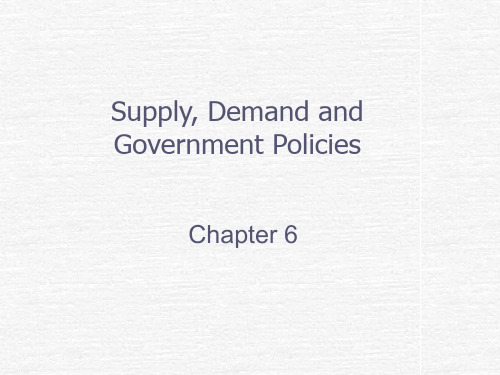
Example: Gasoline shortage of the 1970s
nonprice rationing
Examples: Long lines, Discrimination by sellers
Lines at the Gas Pump
Price of Gasoline
1. Initially,
the
price ceiling
is not
binding...
$4
P1
Supply
Price ceiling
Demand
0
Q1
Quantity of Gasoline
The Price Ceiling on Gasoline Is
ห้องสมุดไป่ตู้Price of Gasoline
Price Floors
When the government imposes a price floor, two outcomes are possible.
The price floor is not binding if set below the equilibrium price. The price floor is binding if set above
Examples: The minimum wage, Agricultural price supports
The Minimum Wage
An important example of a price floor is the minimum wage. Minimum wage laws
dictate the lowest price possible for labor that any
中文曼昆宏观经济学第七版讲义

S
model to
determine
r*
the impact of
an increase in investment
NX1
demand on
NX, S, I, and
net capital
outflow.
I1
I (r )1
S, I
ANSWERS:
3. An increase in investment demand
13
Assumptions about capital flows
a. domestic & foreign bonds are perfect substitutes (same risk, maturity, etc.)
b. perfect capital mobility: no restrictions on international trade in assets
12
National saving: The supply of loanable funds
r
SYC(YT)G
As in Chapter 3, national saving does
not depend on the interest rate
S
S, I
CHAPTER 5 The Open Economy
= net outflow of “loanable funds” = net purchases of foreign assets
the country’s purchases of foreign assets minus foreign purchases of domestic assets
曼昆经济学原理04供给需求及市场力量PPT课件
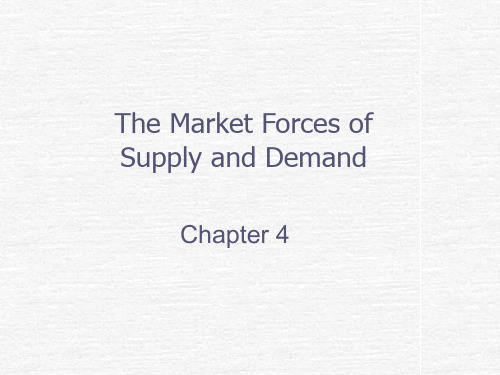
P ric e $ 0 .0 0
0 .5 0 1 .0 0 1 .5 0 2 .0 0 2 .5 0 3 .0 0
Q u a n tity 12 10 8 6 4 2 0
12
Determinants of Demand
Market price Consumer income Prices of related goods Tastes Expectations
0
12
A
D1
20
Number of Cigarettes
Smoked per Day20
Change in Quantity Demanded versus Change in Demand
Change in Demand
A shift in the demand curve, either to the left or right.
D2
D1
2 3 4 5 6 7 8 9 10 11 12
Quantity of Ice-Cream Cones 25
Prices of Related Goods
Substitutes & Complements When a fall in the price of one good reduces the demand for another good,
The Market Forces of Supply and Demand
Chapter 4
The Market Forces of Supply and Demand
Supply and demand are the two
words that economists use most often.
经济学原理 曼昆第七版第四讲讲义:Supply and Demand

7
Markets and Competition
• Perfectly competitive market
– Goods offered for sale are all exactly the same
– Buyers and sellers are so numerous
– Price; market equilibrium; efficiency 3
Markets and Competition
• Supply and demand
– Words economists use most often – The forces that make market economies
Chapter 4 Supply and Demand
Fall 2017f you are making real estate investment decisions, how would you predict the effect of the policy changes?
• A Market is a mechanism through which buyers and sellers interact to determine prices and exchange goods, services, and assets
– Geographical area; – Time period; – Good/service being traded
– Amount of a good that buyers are willing and able to purchase
中文曼昆宏观经济学第七版讲义
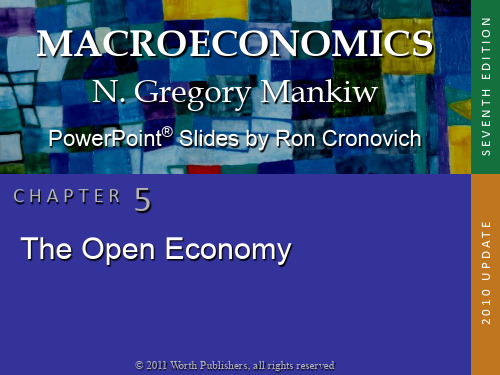
r 1*
NX2 S 1 NX1
Results:
I 0
N X I0
I
(
r
* 2
)
CHAPTER 5 The Open Economy
I
(
r
* 1
)
I (r )
S, I
21
NOW YOU TRY:
3. An increase in investment demand
r
Use the
2010 UPDATE
In this chapter, you will learn:
accounting identities for the open economy
the small open economy model
what makes it “small” how the trade balance and exchange rate
capital outflow
and net exports
CHAPTER 5 The Open Economy
S NX
I (r )
I1
S, I
17
Next, three experiments:
1. Fiscal policy at home 2. Fiscal policy abroad 3. An increase in investment demand
9
Saving, investment, and the trade balance
(percent of GDP) 1960-2019
investment
saving
trade balance (right scale)
微观经济学原理(第七版) 曼昆 名词解释(带英文)

微观经济学原理曼昆名词解释稀缺性(scarcity):社会资源的有限性。
经济学(economics):研究社会如何管理自己的稀缺资源。
效率(efficiency):社会能从其稀缺资源中得到最多东西的特性。
平等(equality):经济成果在社会成员中公平分配的特性。
机会成本(opportunity cost):为了得到某种东西所必须放弃的东西。
理性人(rational people):系统而有目的地尽最大努力实现起目标的人。
边际变动(marginal change):对行动计划微小的增量调整。
激励(incentive):引起一个人做出某种行为的某种东西。
市场经济(market economy):当许多企业和家庭在物品与劳务市场上相互交易时,通过他们的分散决策配置资源的经济。
产权(property rights):个人拥有并控制稀缺资源的能力。
市场失灵(market failure):市场本身不能有效配置资源的情况。
外部性(externality):一个人的行为对旁观者福利的影响。
市场势力(market power):一个经济活动者(或经济活动者的一个小集团)对市场价格有显著影响的能力。
生产率(productivity):一个工人一小时所生产的物品与劳务量。
通货膨胀(inflation):经济中物价总水平的上升。
经济周期(business cycle):就业和生产等经济活动的波动(就是生产这类经济活动的波动。
)循环流向图(circular-flow diagram):一个说明货币如何通过市场在家庭与企业之间流动的直观经济模型。
生产可能性边界(production possibilities frontier):表示一个经济在可得到的生产要素与生产技术既定时所能生产的产量的各种组合的图形。
微观经济学(microeconomics):研究家庭和企业如何做出决策,以及它们在市场上的相互交易。
宏观经济学(macroeconomics):研究整体经济现象,包括通货膨胀、失业和经济增长。
经济学原理 曼昆 英文
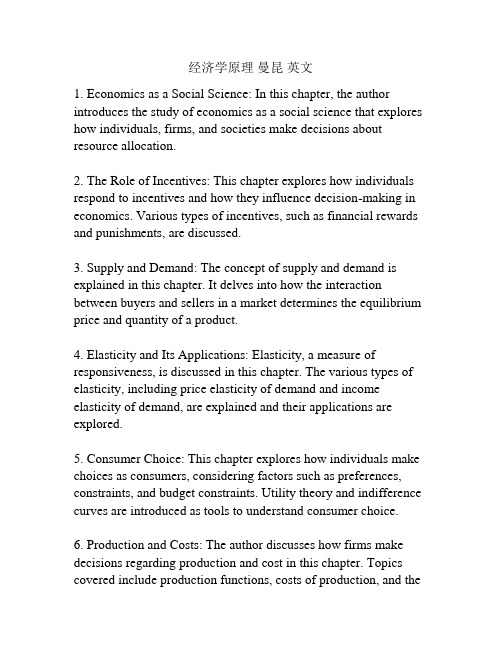
经济学原理曼昆英文1. Economics as a Social Science: In this chapter, the author introduces the study of economics as a social science that explores how individuals, firms, and societies make decisions about resource allocation.2. The Role of Incentives: This chapter explores how individuals respond to incentives and how they influence decision-making in economics. Various types of incentives, such as financial rewards and punishments, are discussed.3. Supply and Demand: The concept of supply and demand is explained in this chapter. It delves into how the interaction between buyers and sellers in a market determines the equilibrium price and quantity of a product.4. Elasticity and Its Applications: Elasticity, a measure of responsiveness, is discussed in this chapter. The various types of elasticity, including price elasticity of demand and income elasticity of demand, are explained and their applications are explored.5. Consumer Choice: This chapter explores how individuals make choices as consumers, considering factors such as preferences, constraints, and budget constraints. Utility theory and indifference curves are introduced as tools to understand consumer choice.6. Production and Costs: The author discusses how firms make decisions regarding production and cost in this chapter. Topics covered include production functions, costs of production, and theconcept of economies of scale.7. Perfect Competition: This chapter explores the characteristics of perfect competition, including the large number of buyers and sellers, homogenous products, and ease of entry and exit. It also examines the implications of perfect competition on market outcomes.8. Monopoly: The concept of monopoly, where a single firm controls the market, is discussed in this chapter. The author analyzes the sources of monopoly power and its implications for prices and output in the market.9. Market Failures and Government Intervention: This chapter examines market failures, situations where the market fails to allocate resources efficiently. Different types of market failures, such as externalities and public goods, are explained, along with the role of government intervention in correcting these failures.10. Externalities: Externalities, or the consequences of economic activities on third parties, are explored in this chapter. The author discusses positive and negative externalities and their implications for resource allocation.11. Public Goods and Common Resources: This chapter focuses on the characteristics of public goods and common resources. It discusses the free-rider problem and the challenges in providing public goods efficiently.12. Markets for Factors of Production: The author explores themarkets for factors of production, including labor and capital, in this chapter. Wage determination, discrimination, and other factors influencing the prices of these factors are analyzed.13. The Economics of Income Inequality: Income inequality and its causes are discussed in this chapter. The author explores different theories and factors that contribute to income inequality, as well as its implications for society and policy considerations.14. The Theory of Consumer Choice: This chapter delves deeper into the theory of consumer choice, examining topics such as consumer preferences, budget constraints, and the concept of utility maximization.15. Frontiers of Microeconomics: The final chapter explores the frontiers of microeconomics, including topics such as behavioral economics, game theory, and the economics of information. The author discusses how these fields have expanded our understanding of economic behavior.。
曼昆微观经济学Chapter4 The Market Forces of Supply and Demand
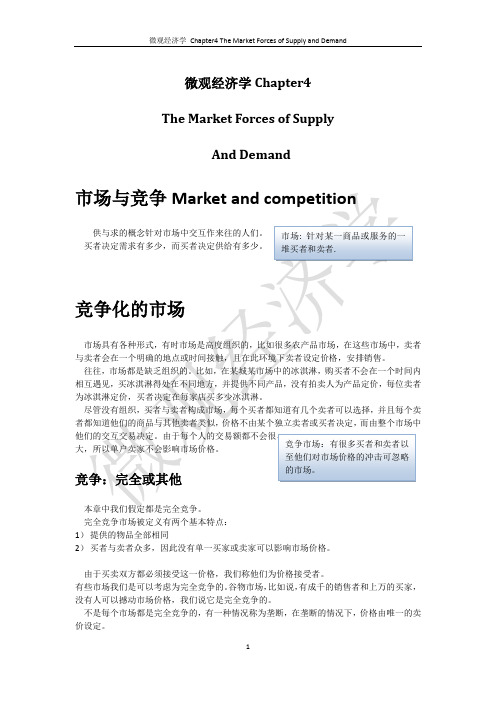
微观经济学Chapter4The Market Forces of SupplyAnd Demand完全竞争市场被定义有两个基本特点:1)提供的物品全部相同2)买者与卖者众多,因此没有单一买家或卖家可以影响市场价格。
由于买卖双方都必须接受这一价格,我们称他们为价格接受者。
有些市场我们是可以考虑为完全竞争的。
谷物市场,比如说,有成千的销售者和上万的买家,没有人可以撼动市场价格,我们说它是完全竞争的。
不是每个市场都是完全竞争的,有一种情况称为垄断,在垄断的情况下,价格由唯一的卖价设定。
一些市场介于完全竞争与垄断之间,称为寡头垄断:由一定数量的卖家,但并不激烈地竞争。
航空公司是一个范例,如果一条航线只由两到三个载运承担,则这些承运者可以躲避竞争,从而使机票价格保持在高位。
另一种竞争是垄断竞争。
市场中有很多买家,但他们的商品不尽相同,因此他们有权为自己定价。
举例:杂志。
杂志竞争中,市场里随时都能闯入新人,并开创新的杂志。
尽管今天市场种产品多样,我们仍要从完全竞争学起。
完全竞争市场在这当中最容易分析。
需求Figure 3(需求增长,曲线右移,需求下降,曲线左移)指出,有很多变数可以影响需求曲线,以下是一些主要的:收入(Income )低收入意味着你的支出将减少,低而降低了,我们就说这种商品为normal good .不是所有商品都为一般商品,如果收入下降而需求升高,则我们称该商品为替代商品(Inferior good )。
就像,收入降低时,我们不会去买车或打出租车,而改坐公交。
1234567相关产品价格(Price of Related Goods)假如,冻酸奶的价格下降,则需求定理告诉我们,我们可能去购买冻得更好的酸奶。
同时,你会减少冰淇淋的购买量。
因为冰淇淋和冻酸奶都是冷的、甜的、奶油制甜品,他们满足人本呈负相关。
技术(Technology)技术有利于降低商品成本,解放人力,降低成本后,先进的技术增加了供给量。
- 1、下载文档前请自行甄别文档内容的完整性,平台不提供额外的编辑、内容补充、找答案等附加服务。
- 2、"仅部分预览"的文档,不可在线预览部分如存在完整性等问题,可反馈申请退款(可完整预览的文档不适用该条件!)。
- 3、如文档侵犯您的权益,请联系客服反馈,我们会尽快为您处理(人工客服工作时间:9:00-18:30)。
The “indivisible hand”
No single individual or organization or government is responsible for solving the economic problems in a market economy Our society, despite of its fragility (surprise!), functions well for most of the time in a spontaneous manner
8
h
Markets and Competition
Monopoly The only seller in the market Sets the price
Other markets Between perfect competition and monopoly
9
h
Demand
Quantity demanded Amount of a good that buyers are willing and able to purchase
To know how market help to solve the important questions and to be
3
h
Markets and Competition
Supply and demand Words economists use most often The forces that make market economies work Refer to the behavior of people as they interact with one another in competitive markets
Sellers as a group
• Determine the supply of the product5 Nhomakorabeah
Markets and Competition
Markets take many forms Highly organized
• Markets for many agricultural commodities
What are the real factor driving the residential housing price in China?
What are the long-run perspectives of Chinese real estate markets?
2
h
The Market Mechanism
4
h
Markets and Competition
Market A group of buyers and sellers of a particular good or service Buyers as a group
• Determine the demand for the product
Less organized
• Market for ice cream in a particular town
6
h
Markets and Competition
Competitive market Market in which there are many buyers and many sellers Each has a negligible impact on market price Price and quantity are determined by all buyers and sellers
10
h
Demand
Demand Relationship between the price of a good and quantity demanded Demand schedule: a table Demand curve: a graph
• Price on the vertical axis • Quantity on the horizontal axis
A Market is a mechanism through which buyers and sellers interact
to determine prices and exchange goods, services, and assets
Geographical area;
Time period;
• As they interact in the marketplace
7
h
Markets and Competition
Perfectly competitive market Goods offered for sale are all exactly the same Buyers and sellers are so numerous
• No single buyer or seller has any influence over the market price • Price takers
At the market price
• Buyers can buy all they want • Sellers can sell all they want
Law of demand Other things equal When the price of a good rises, the quantity demanded of the good falls When the price falls, the quantity demanded rises
Chapter 4 Supply and Demand
Fall 2017
1
h
Questions
If you are making real estate investment decisions, how would you predict the effect of the policy changes?
